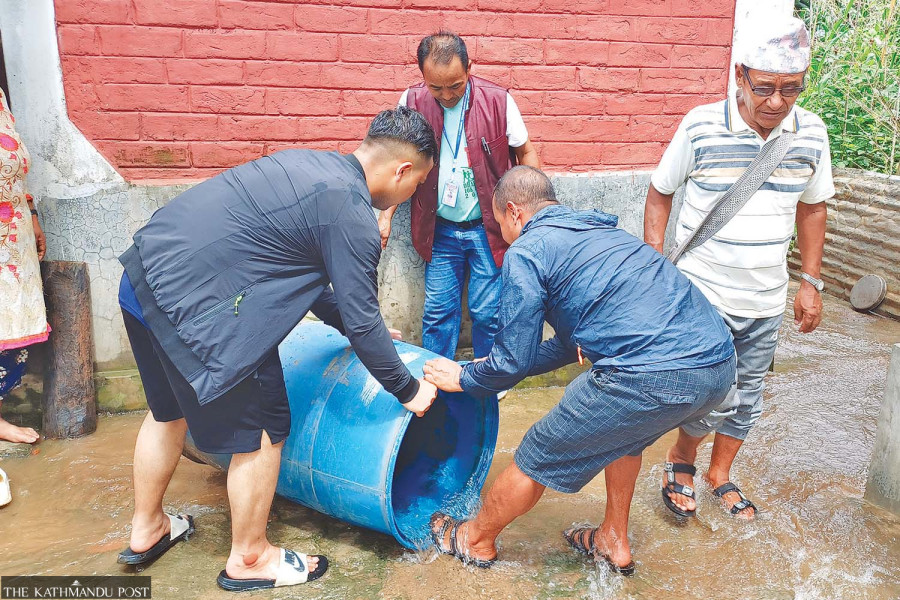Health
Serotype-3 of dengue virus wreaks havoc in Sunsari settlements
At least nine people have died and more than 6,000 have been infected due to the virus so far.
Arjun Poudel
The Serotype-3, also known as DENV-3, of the dengue virus has been found responsible for a massive outbreak of the deadly disease in Sunsari district. The disease has killed at least nine and infected around 4,000 people in the district so far.
The National Public Health Laboratory and BP Koirala Institute of Health Sciences, which carried out serotyping of the virus on clinical samples of the infected persons a few days ago, show that serotype-3 (DENV-3) is the main culprit for the epidemic in Dharan.
“Serotype-1 has been also detected in some clinical samples but serotype-3 has been found in most of the samples,” said Dr Gokarna Dahal, chief of the Vector Control Section at the division. “Infection from the new serotype of the virus could be the reason for the high severity rate.”
Sunsari district was the epicentre of the dengue outbreak in 2019 in which at least six people died and over 16,000 were hospitalised due to infection of the virus that spread in 68 districts. But serotype-2 (DENV-2) of the virus was responsible for the outbreak at the time.
“But when a new serotype of the dengue virus spreads in places, in which another serotype of the virus has spread in the past, severity and death rate increases,” said Professor Murari Das, an entomologist at the BP Koirala Institute of Health Sciences.
Dengue is a mosquito-borne disease transmitted by female Aedes aegypti and Aedes albopictus mosquitoes. The same vector also transmits chikungunya, yellow fever, and Zika, according to the World Health Organisation.
Last year, virus serotypes DENV-1, DENV-2, and DENV-3 were found responsible for the dengue epidemic in the country. There are five serotypes of dengue, numbered 1 through 5.
At least nine have died and around 6,000 cases of dengue infection have been reported from 70 districts throughout the country since the start of 2023. Of the total cases of infection, Sunsari reported over 3,500 cases and Dharan Sub-metropolitan City reported over 2,700 cases. Officials at the Ministry of Health and Population say that most of the cases of infection have been reported in the last month.
Kalikot, Humla, Mugu, Pyuthan, Dhanusha, Solukhumbu and Rolpa are the districts that have not yet reported cases of infection this year.
Due to the huge flow of infected patients, the BP Koirala Institute of Health Sciences has been overwhelmed. The hospital administration has been treating seriously ailing patients off the floor. According to the hospital administration, beds in the hospital’s emergency ward, Covid ward, observation wards and several other departments are occupied by dengue patients. Dozens of patients with serious complications have been visiting hospitals for treatment every day.
The hospital has converted its 100-bed Covid ward into dengue ward. A separate dengue special clinic has been brought into operation after the hospital’s outpatient department was overwhelmed with dengue patients. Several doctors, nurses, paramedics and other hospital staff have also been infected with dengue and this has affected service delivery.
Along with Dharan, there are problems with case management in health facilities of Dhading district, officials say.
The Dharan Sub-metropolis has shut down all schools operating at the local level from Wednesday and started a ‘dengue search-and-destroy’ drive.
Kathmandu district has recorded 96 cases of dengue infection this year. Lalitpur and Bhaktapur recorded less than 40 cases, according to officials.
Last year, 88 people died and more than 54,000 were infected with the virus, which had spread to all 77 districts of the country. Hospitals in Kathmandu Valley were overwhelmed with dengue patients and many complained that they were deprived of treatment. At the time, pharmacies had run out of paracetamol, the most widely used medicine to treat fever.
The post-monsoon time is considered the peak season for dengue transmissions, but the country has already witnessed outbreaks of the potentially deadly disease since the start of the year. Experts say the virus has become endemic with cases of dengue reported throughout the year.
Experts say unless the lessons and experiences gained in the previous outbreaks are implemented, the disease will not stop spreading. They say the real number of infections could be several times higher, as the government’s case reporting system is not very effective and more than 80 percent of the cases are asymptomatic. Many people infected with dengue show mild symptoms, which do not need any treatment or can be treated with paracetamol at home.
Dengue-transmitting mosquitoes breed in clean water and bite people in daylight. Uncovered water tanks and discarded objects such as plastic cups and bottles could be breeding grounds for dengue-carrying mosquitoes.
“Dengue ‘search and destroy’ should be a regular and widespread effort if we have to get rid of infection,” said Das. “Otherwise, infection will continue to spread.”
According to doctors, mild to high fever, severe muscle pain, rashes, severe headache and pain in the eyes are some symptoms of dengue. Doctors advise that those with these symptoms should seek immediate treatment. While there is no specific cure for the disease, early detection and access to proper medical care can lower fatalities.




 6.12°C Kathmandu
6.12°C Kathmandu













%20(1).jpg&w=300&height=200)
